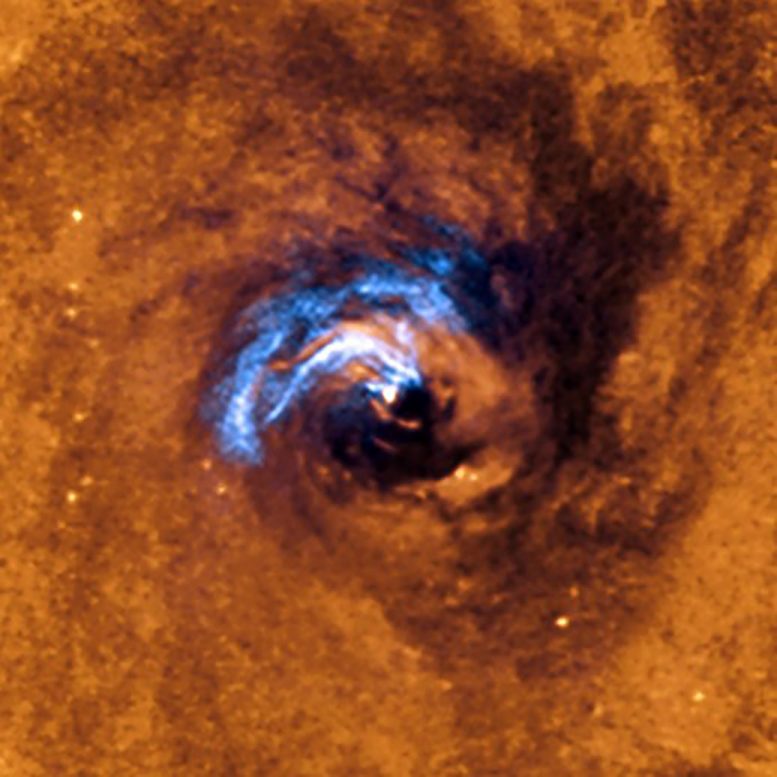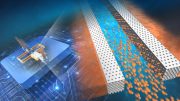
The image shows the process of nuclear feeding of a black hole in the galaxy NGC 1566, and how the dust filaments, which surround the active nucleus, are trapped and rotate in a spiral around the black hole until it swallows them. Credit: European Southern Observatory (ESO)
The black holes at the centers of galaxies are the most mysterious objects in the Universe, not only because of the huge quantities of material within them, millions of times the mass of the Sun, but because of the incredibly dense concentration of matter in a volume no bigger than that of our Solar System. When they capture matter from their surroundings they become active, and can send out enormous quantities of energy from the capture process, although it is not easy to detect the black hole during these capture episodes, which are not frequent.
However, a study led by the researcher Almudena Prieto, of the Instituto de Astrofísica de Canarias (IAC), has discovered long narrow dust filaments which surround and feed these black holes in the centers of galaxies, and which could be the natural cause of the darkening of the centers of many galaxies when their nuclear black holes are active. The results of this study have recently been published in the journal Monthly Notices of the Royal Astronomical Society (MNRAS).
Using images from the Hubble Space Telescope, the Very Large Telescope (VLT) at the European Southern Observatory (ESO), and the Atacama Large Millimeter Array (ALMA) in Chile, the scientists have been able to obtain a direct visualization of the process of nuclear feeding of a black hole in the galaxy NGC 1566 by these filaments. The combined images show a snapshot in which one can see how the dust filaments separate, and then go directly towards the center of the galaxy, where they circulate and rotate in a spiral around the black hole before being swallowed by it.
“This group of telescopes has given us a completely new perspective of a supermassive black hole, thanks to the imaging at high angular resolution and the panoramic visualization of its surroundings, because it lets us follow the disappearance of the dust filaments as they fall into the black hole,” explains Almudena Prieto, the first author on the paper.
The study is the result of the long-term PARSEC project of the IAC, which aims to understand how supermassive black holes wake up from their long lives of hibernation, and after a process in which they accrete material from their surroundings, they become the most powerful objects in the Universe.
Reference: “Dust in the central parsecs of unobscured AGN: more challenges to the torus” by M. Almudena Prieto, Jakub Nadolny, Juan A. Fernández-Ontiveros and Mar Mezcua, 16 June 2021, Monthly Notices of the Royal Astronomical Society.
DOI: 10.1093/mnras/stab1704
Part of this work was carried out within the Master’s thesis in Astrophysics of the University of La Laguna of Jakub Nadolny, carried out at the IAC within the PARSEC project. Researchers Mar Mezcua and Juan A. Fernández Ontiveros were also advisers to this work, while they had PARSEC postdoctoral contracts at the IAC.









Forget about black holes. In the centers of galaxies is quark matter synthesized from strings in the center of the universe, which in synthesis reactions gives birth to all the stars. They do not eat dust and gas – they have different gravity frequencies.
Well, you can be absolutely certain the rest of us will forget your baseless pseudoscience on account of black hole observations and their science.
I knew we were idiots, but this is just saying the scientists are tryna kill us all in a century or two. Still, it’s interesting.
Never mind the baseless conspiracy theory – have you met scientists? They are socially conscious as seen in statistics, and we benefit hugely from their work (as for instance the web shows – invented at CERN).
Studying the “Zoo of Particles” (broken or glued together in collisions) is the same as studying and assigning names to shell fragments – a useless exercise .. It’s time to throw history in the dustbin along with the fake Higgs Boson and nonexistent gravitational waves.
The Higgs boson (a particle of God) in translation means a deaf dead end in physics (and God knows what kind of particle it is that gives gravity)This monpassier of 130 protons stuck together in the collider lives only 1.56 × 10 ^ −22 s. and has no time to influence anything.
So are gravitational waves. Scientists saw the waves, I have no doubt, but these are not gravitational, but shock detonation waves that have nothing to do with gravity.
And gravity is the jet thrust of ordinary electromagnetic waves.
ALMA kicks ass as usual [ https://arxiv.org/pdf/2106.07753.pdf ].
“A parsec-scale dusty torus is thought to be the cause of active galactic nuclei (AGN) dichotomy in the 1/2 types, narrow/broad emission lines.”
“The key difference is that in the type 2 AGN, the nuclear filaments happen to be optically thick enough to obscure the nucleus at the optical/UV wavelengths, whereas in type 1 and intermediate-type, the optical thickness at the nucleus is a factor 2–3 lower, hence the nucleus is always visible.”
“Filaments and lanes are traced by equivalent structures in molecular cold and warm gas in CO, HCN and H2. A single filament can be seen either getting straight- or spiralling- to the centre, suggesting their role as streamers to channel material from galactic scales to the centre. Kinematic evidence is proving that be the case in different degrees, from a few tenth of solar masses per year in low Eddington sources to solar in the standard 1% – 10% Eddington cases.
These large-scale dust structures may end up in the high extinctions inferred at parsec scale in type 2 AGN, and thought to be caused by a torus. The difference with the present scenario is that obscuration arises naturally, by galactic-scale filaments and lanes ubiquitous to any galaxy converging to centre. These structures may fulfil the role of the putative parsecs-scale torus.”
As a reference, the EHT work on the M87* black hole shadow and accretion disk that showed polarization spirals in the latter didn’t look at disk flow structures (but used the Magnetically Arrested Disk [MAD] model).
“The net EVPA pattern of the M87* polarization maps is predominantly azimuthal. In the context of semi-analytic models with imposed, idealized magnetic field geometry, such a pattern can be reproduced using a significant component of poloidal (radial and/or vertical) magnetic field. The presence of such magnetic fields in a rotating fluid would imply that the magnetic fields are dynamically important. However, significant Faraday rotation may be present and it is not clear whether the observed EVPA pattern can be interpreted in terms of magnetic field structure alone.”
It is possible that the new results would help bridge the gap between having solely magnetic field and having components of plasma streamers in the MHD models.